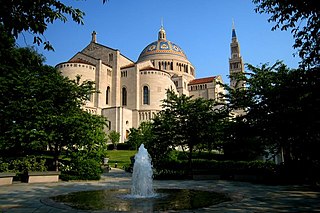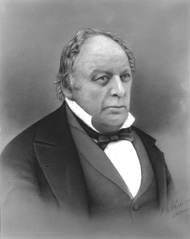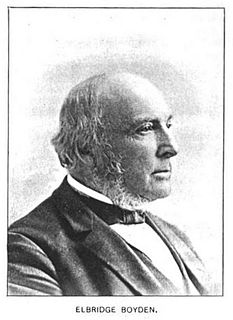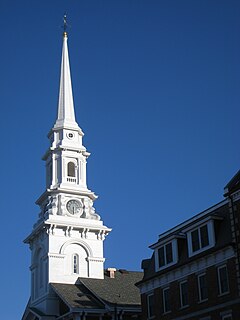
Henry Hobson Richardson was a prominent North American architect, best known for his work in a style that became known as Richardsonian Romanesque. Along with Louis Sullivan and Frank Lloyd Wright, Richardson is one of "the recognized trinity of American architecture".

Allegheny Cemetery is a historic rural cemetery and is one of the largest and oldest burial grounds in Pittsburgh, Pennsylvania, USA.

Richard Upjohn was a British-born American architect who emigrated to the United States and became most famous for his Gothic Revival churches. He was partially responsible for launching the movement to such popularity in the United States. Upjohn also did extensive work in and helped to popularize the Italianate style. He was a founder and the first president of the American Institute of Architects. His son, Richard Michell Upjohn, (1828-1903), was also a well-known architect and served as a partner in his continued architectural firm in New York.

Maginnis & Walsh was an architecture firm started by Charles Donagh Maginnis and Timothy Walsh in 1905. It was known for its innovative design of churches in Boston in the first half of the twentieth century.

Alexander Parris was a prominent American architect-engineer. Beginning as a housewright, he evolved into an architect whose work transitioned from Federal style architecture to the later Greek Revival. Parris taught Ammi B. Young, and was among the group of architects influential in founding what would become the American Institute of Architects. He is also responsible for the designs of many lighthouses along the coastal Northeastern United States.

Charles Howland Hammatt Billings (1818–1874) was an artist and architect from Boston, Massachusetts.

Ammi Burnham Young was a 19th-century American architect whose commissions transitioned from the Greek Revival to the Neo-Renaissance styles. His design of the second Vermont State House brought him fame and success, which eventually led him to become the first Supervising Architect of the U.S. Treasury Department. As federal architect, he was responsible for creating across the United States numerous custom houses, post offices, courthouses and hospitals, many of which are today on the National Register. His traditional architectural forms lent a sense of grandeur and permanence to the new country's institutions and communities. Young pioneered the use of iron in construction.
Dr. James F. O'Gorman is a leading American architectural historian, author, lecturer, editor, and consultant who taught for many years at Wellesley College. O'Gorman received a B.Arch. degree from Washington University in St. Louis in 1956 and an M.Arch. from the University of Illinois, Urbana-Champaign, in 1961. He earned a Ph.D. in Art History from Harvard University in 1966.

The Boston Museum (1841–1903), also called the Boston Museum and Gallery of Fine Arts, was a theatre, wax museum, natural history museum, zoo, and art museum in 19th-century Boston, Massachusetts. Moses Kimball established the enterprise in 1841.

Alexander Rice Esty was an American architect known for designing many Gothic Revival churches in New England, however his work also encompassed university buildings, public buildings, office buildings, and private residences across the Northeastern United States.

William G. (Gibbons) Preston was an American architect who practiced during the last third of the nineteenth century and in the first decade of the twentieth. Educated at Harvard University and the École des Beaux-Arts in Paris., he was active in Boston, New York, Rhode Island, Ohio, New Brunswick and Savannah, Georgia, where he was brought by George Johnson Baldwin to design the Chatham County courthouse. Preston stayed in Savannah for several years during which time designed the original Desoto Hotel, the Savannah Volunteer Guards Armory and 20 other distinguished public buildings and private homes. He began his professional career working for his father, the builder and architect Jonathan Preston (1801–1888), upon his return to the United States from the École in 1861, and was the sole practitioner in the office from the time his father retired c. 1875 until he took John Kahlmeyer as a partner in about 1885.

Hartwell and Richardson was a Boston, Massachusetts architectural firm established in 1881, by Henry Walker Hartwell (1833–1919) and William Cummings Richardson (1854–1935). The firm contributed significantly to the current building stock and architecture of the greater Boston area. Many of its buildings are listed on the National Register of Historic Places.

Elbridge Boyden (1810–1898) was a prominent 19th-century American architect from Worcester, Massachusetts who designed numerous civil and public buildings throughout New England and other parts of the United States. Perhaps his best known works are the Taunton State Hospital (1851) and Mechanics Hall (1855) in Worcester.
Odd Fellows Hall (1872–1932) in Boston, Massachusetts, was built for the Independent Order of Odd Fellows, Grand Lodge of Massachusetts. It occupied a large lot in the South End, at no.515 Tremont Street at Berkeley Street. Architect Joseph Billings designed the structure which had several large meeting rooms: Covenant Hall, Encampment Hall, Friendship Hall, Oasis Hall. Tenants included Emerson College of Oratory. Among the events that took place in the hall: 1892 annual dinner of the Tremont House Waiters’ Association. In January 1932 fire destroyed the building.

Andrew Carney (1794–1864) immigrated to the United States in 1816. Carney partnered with Jacob Sleeper to form Carney & Sleeper, Clothiers. Carney was a wise investor and grew his fortune with investments in Boston's real estate market. Carney's interests turned to finance and he assisted in founding the First National Bank of Boston and the John Hancock Insurance Company for which he worked as a director. Carney cared for the youth of Boston by founding the St. Vincent Home for Girls, and was a benefactor of the House of the Angel Guardian for Homeless Boys and the Home for Destitute Catholic Children. Carney worked with Jesuit leaders in Boston, and helped finance the Church of the Immaculate Conception and Boston College in 1863. Carney established Carney Hospital, the first Catholic hospital in New England in 1863.

Alpheus C. Morse (1818-1893) was an American architect with offices in Providence, Rhode Island.

Richard Bond (1798–1861) was an early American architect who practiced primarily in Boston, Massachusetts.

John D. Towle was an American architect.

Isaac Melvin (1811-1853) was an American architect from Massachusetts.

The architecture of Boston is a robust combination of old and new architecture. As one of the oldest cities in North America, Boston, Massachusetts has accumulated buildings and structures ranging from the 17th-century to the present day, having evolved from a small port town to a large cosmopolitan center for education, industry, finance, and technology. The city is known for its granite buildings stemming from its early days. It is also known for being one of the origins of Federal Architecture.


















